Project Management: Car Pooling Business Idea for Sydney, Part 2
VerifiedAdded on 2020/03/16
|11
|3853
|46
Project
AI Summary
This project presents a carpooling business idea tailored for Sydney, Australia, addressing the city's traffic congestion issues. The project begins by identifying the target population, which includes Sydney workers burdened by significant time wasted in traffic, costing them a substantial portion of their salaries. The proposed solution involves a ride-sharing application that connects drivers and passengers, offering a convenient and cost-effective alternative to individual car usage. The business model details a revenue-sharing approach where the application developer, SydShare, takes a percentage of the fares. The project evaluates the feasibility of the idea, projecting substantial pre-tax profits based on a percentage of Sydney commuters adopting the ride-sharing service. The reflection section outlines the team's roles, the team leader's approach to project management, and the agile methods used in the idea generation and evaluation process, including scoring and weighting criteria to objectively select the most promising business concept. This project aims to reduce traffic, pollution, and increase economic productivity.
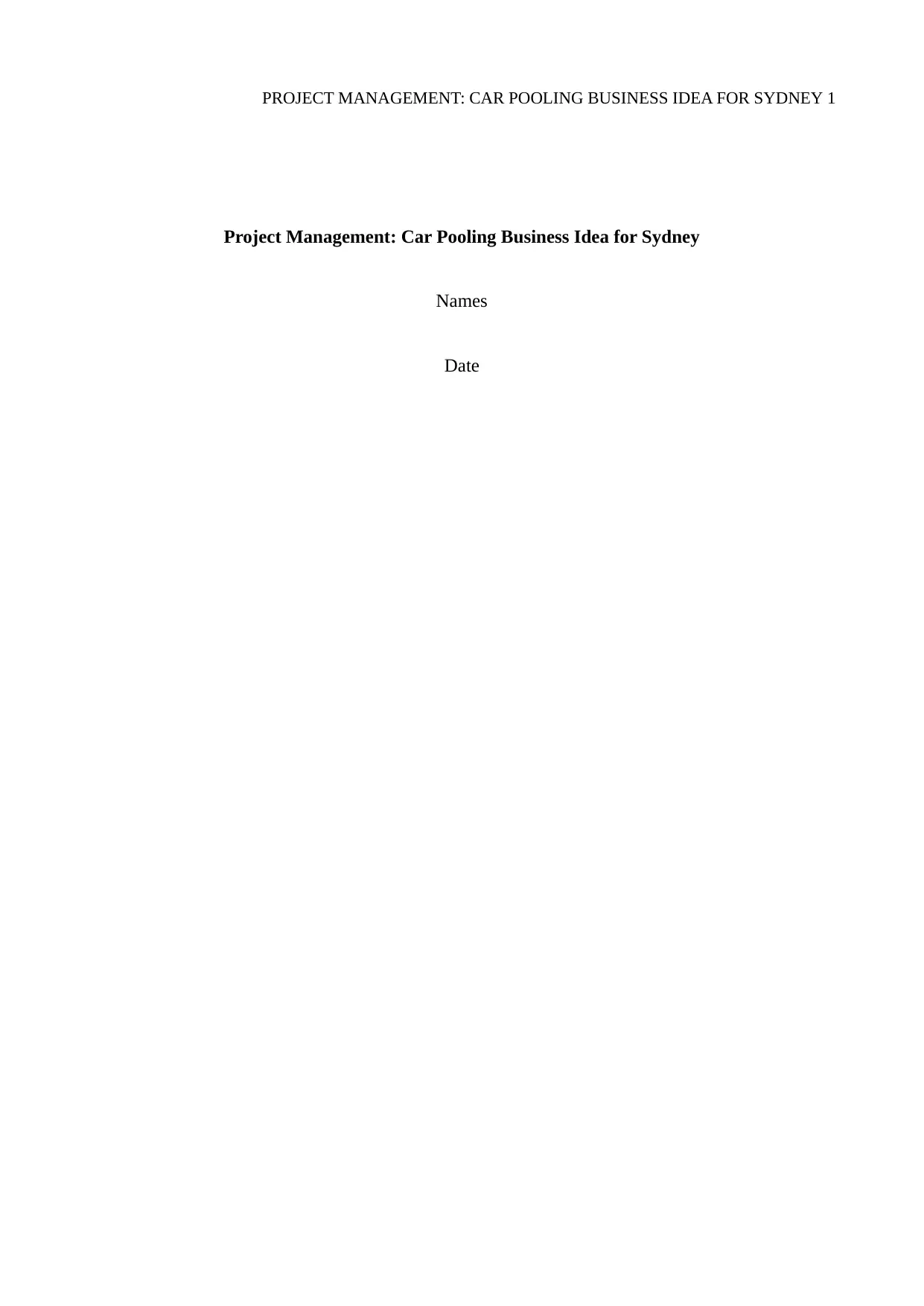
PROJECT MANAGEMENT: CAR POOLING BUSINESS IDEA FOR SYDNEY 1
Project Management: Car Pooling Business Idea for Sydney
Names
Date
Project Management: Car Pooling Business Idea for Sydney
Names
Date
Paraphrase This Document
Need a fresh take? Get an instant paraphrase of this document with our AI Paraphraser
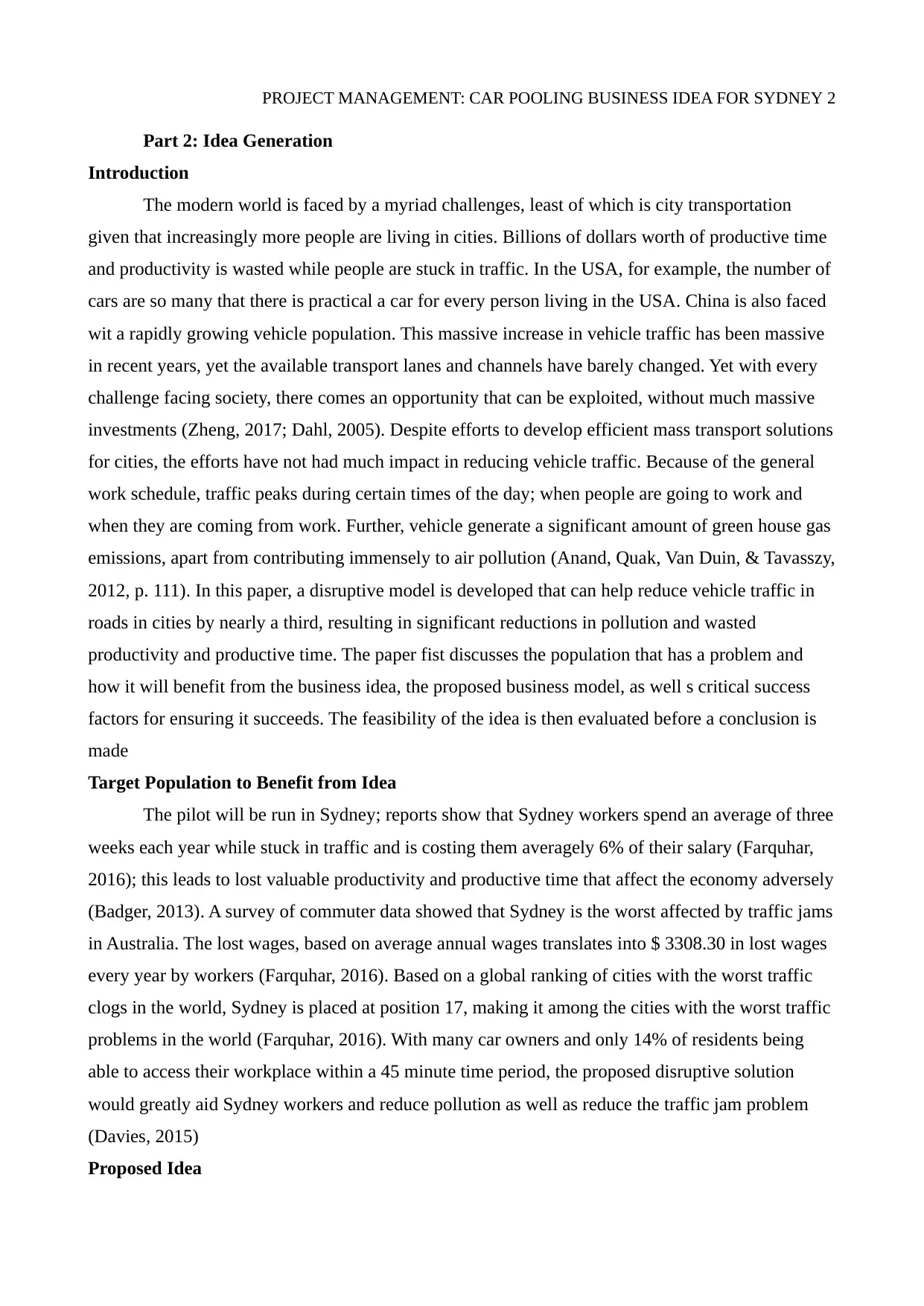
PROJECT MANAGEMENT: CAR POOLING BUSINESS IDEA FOR SYDNEY 2
Part 2: Idea Generation
Introduction
The modern world is faced by a myriad challenges, least of which is city transportation
given that increasingly more people are living in cities. Billions of dollars worth of productive time
and productivity is wasted while people are stuck in traffic. In the USA, for example, the number of
cars are so many that there is practical a car for every person living in the USA. China is also faced
wit a rapidly growing vehicle population. This massive increase in vehicle traffic has been massive
in recent years, yet the available transport lanes and channels have barely changed. Yet with every
challenge facing society, there comes an opportunity that can be exploited, without much massive
investments (Zheng, 2017; Dahl, 2005). Despite efforts to develop efficient mass transport solutions
for cities, the efforts have not had much impact in reducing vehicle traffic. Because of the general
work schedule, traffic peaks during certain times of the day; when people are going to work and
when they are coming from work. Further, vehicle generate a significant amount of green house gas
emissions, apart from contributing immensely to air pollution (Anand, Quak, Van Duin, & Tavasszy,
2012, p. 111). In this paper, a disruptive model is developed that can help reduce vehicle traffic in
roads in cities by nearly a third, resulting in significant reductions in pollution and wasted
productivity and productive time. The paper fist discusses the population that has a problem and
how it will benefit from the business idea, the proposed business model, as well s critical success
factors for ensuring it succeeds. The feasibility of the idea is then evaluated before a conclusion is
made
Target Population to Benefit from Idea
The pilot will be run in Sydney; reports show that Sydney workers spend an average of three
weeks each year while stuck in traffic and is costing them averagely 6% of their salary (Farquhar,
2016); this leads to lost valuable productivity and productive time that affect the economy adversely
(Badger, 2013). A survey of commuter data showed that Sydney is the worst affected by traffic jams
in Australia. The lost wages, based on average annual wages translates into $ 3308.30 in lost wages
every year by workers (Farquhar, 2016). Based on a global ranking of cities with the worst traffic
clogs in the world, Sydney is placed at position 17, making it among the cities with the worst traffic
problems in the world (Farquhar, 2016). With many car owners and only 14% of residents being
able to access their workplace within a 45 minute time period, the proposed disruptive solution
would greatly aid Sydney workers and reduce pollution as well as reduce the traffic jam problem
(Davies, 2015)
Proposed Idea
Part 2: Idea Generation
Introduction
The modern world is faced by a myriad challenges, least of which is city transportation
given that increasingly more people are living in cities. Billions of dollars worth of productive time
and productivity is wasted while people are stuck in traffic. In the USA, for example, the number of
cars are so many that there is practical a car for every person living in the USA. China is also faced
wit a rapidly growing vehicle population. This massive increase in vehicle traffic has been massive
in recent years, yet the available transport lanes and channels have barely changed. Yet with every
challenge facing society, there comes an opportunity that can be exploited, without much massive
investments (Zheng, 2017; Dahl, 2005). Despite efforts to develop efficient mass transport solutions
for cities, the efforts have not had much impact in reducing vehicle traffic. Because of the general
work schedule, traffic peaks during certain times of the day; when people are going to work and
when they are coming from work. Further, vehicle generate a significant amount of green house gas
emissions, apart from contributing immensely to air pollution (Anand, Quak, Van Duin, & Tavasszy,
2012, p. 111). In this paper, a disruptive model is developed that can help reduce vehicle traffic in
roads in cities by nearly a third, resulting in significant reductions in pollution and wasted
productivity and productive time. The paper fist discusses the population that has a problem and
how it will benefit from the business idea, the proposed business model, as well s critical success
factors for ensuring it succeeds. The feasibility of the idea is then evaluated before a conclusion is
made
Target Population to Benefit from Idea
The pilot will be run in Sydney; reports show that Sydney workers spend an average of three
weeks each year while stuck in traffic and is costing them averagely 6% of their salary (Farquhar,
2016); this leads to lost valuable productivity and productive time that affect the economy adversely
(Badger, 2013). A survey of commuter data showed that Sydney is the worst affected by traffic jams
in Australia. The lost wages, based on average annual wages translates into $ 3308.30 in lost wages
every year by workers (Farquhar, 2016). Based on a global ranking of cities with the worst traffic
clogs in the world, Sydney is placed at position 17, making it among the cities with the worst traffic
problems in the world (Farquhar, 2016). With many car owners and only 14% of residents being
able to access their workplace within a 45 minute time period, the proposed disruptive solution
would greatly aid Sydney workers and reduce pollution as well as reduce the traffic jam problem
(Davies, 2015)
Proposed Idea
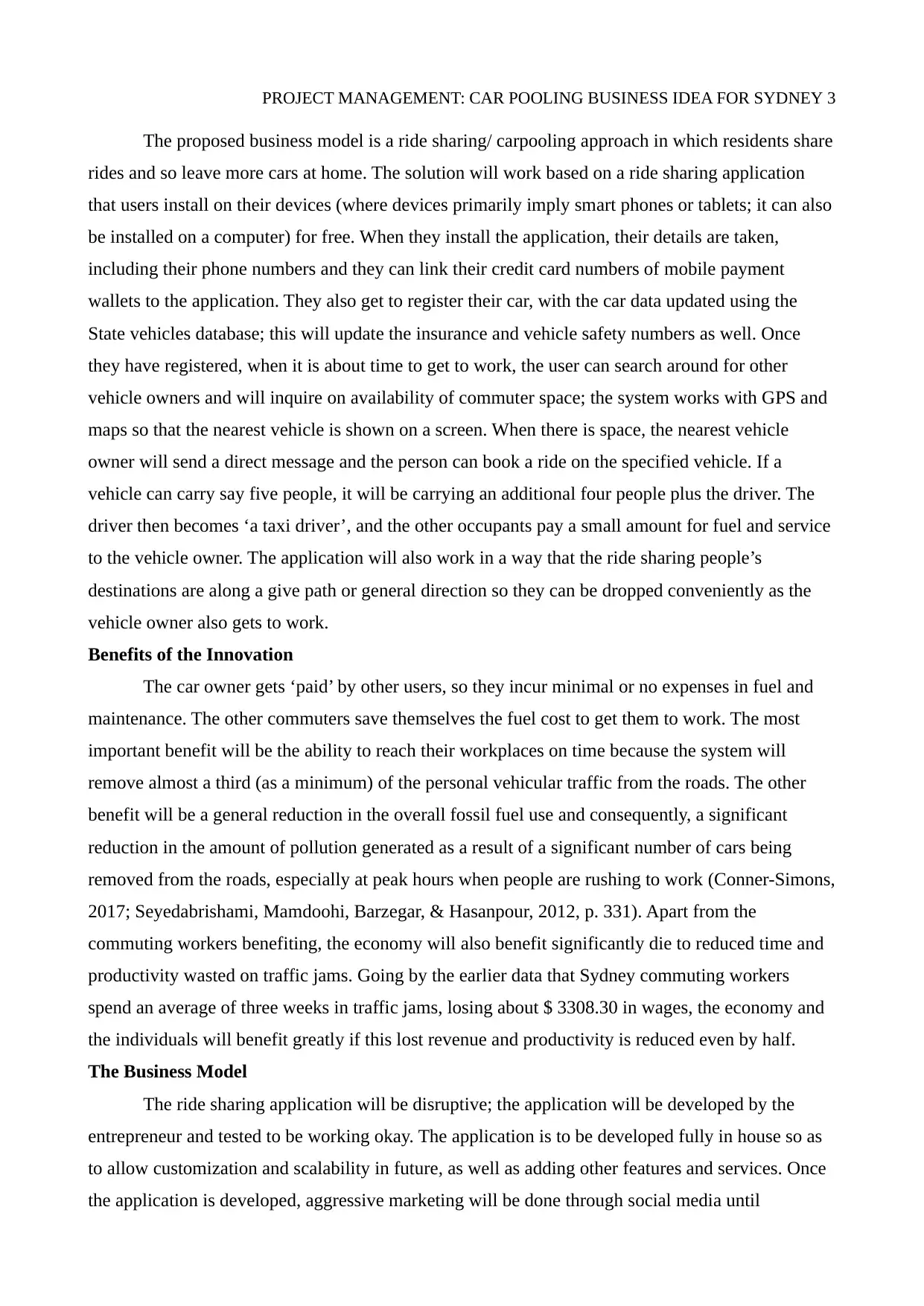
PROJECT MANAGEMENT: CAR POOLING BUSINESS IDEA FOR SYDNEY 3
The proposed business model is a ride sharing/ carpooling approach in which residents share
rides and so leave more cars at home. The solution will work based on a ride sharing application
that users install on their devices (where devices primarily imply smart phones or tablets; it can also
be installed on a computer) for free. When they install the application, their details are taken,
including their phone numbers and they can link their credit card numbers of mobile payment
wallets to the application. They also get to register their car, with the car data updated using the
State vehicles database; this will update the insurance and vehicle safety numbers as well. Once
they have registered, when it is about time to get to work, the user can search around for other
vehicle owners and will inquire on availability of commuter space; the system works with GPS and
maps so that the nearest vehicle is shown on a screen. When there is space, the nearest vehicle
owner will send a direct message and the person can book a ride on the specified vehicle. If a
vehicle can carry say five people, it will be carrying an additional four people plus the driver. The
driver then becomes ‘a taxi driver’, and the other occupants pay a small amount for fuel and service
to the vehicle owner. The application will also work in a way that the ride sharing people’s
destinations are along a give path or general direction so they can be dropped conveniently as the
vehicle owner also gets to work.
Benefits of the Innovation
The car owner gets ‘paid’ by other users, so they incur minimal or no expenses in fuel and
maintenance. The other commuters save themselves the fuel cost to get them to work. The most
important benefit will be the ability to reach their workplaces on time because the system will
remove almost a third (as a minimum) of the personal vehicular traffic from the roads. The other
benefit will be a general reduction in the overall fossil fuel use and consequently, a significant
reduction in the amount of pollution generated as a result of a significant number of cars being
removed from the roads, especially at peak hours when people are rushing to work (Conner-Simons,
2017; Seyedabrishami, Mamdoohi, Barzegar, & Hasanpour, 2012, p. 331). Apart from the
commuting workers benefiting, the economy will also benefit significantly die to reduced time and
productivity wasted on traffic jams. Going by the earlier data that Sydney commuting workers
spend an average of three weeks in traffic jams, losing about $ 3308.30 in wages, the economy and
the individuals will benefit greatly if this lost revenue and productivity is reduced even by half.
The Business Model
The ride sharing application will be disruptive; the application will be developed by the
entrepreneur and tested to be working okay. The application is to be developed fully in house so as
to allow customization and scalability in future, as well as adding other features and services. Once
the application is developed, aggressive marketing will be done through social media until
The proposed business model is a ride sharing/ carpooling approach in which residents share
rides and so leave more cars at home. The solution will work based on a ride sharing application
that users install on their devices (where devices primarily imply smart phones or tablets; it can also
be installed on a computer) for free. When they install the application, their details are taken,
including their phone numbers and they can link their credit card numbers of mobile payment
wallets to the application. They also get to register their car, with the car data updated using the
State vehicles database; this will update the insurance and vehicle safety numbers as well. Once
they have registered, when it is about time to get to work, the user can search around for other
vehicle owners and will inquire on availability of commuter space; the system works with GPS and
maps so that the nearest vehicle is shown on a screen. When there is space, the nearest vehicle
owner will send a direct message and the person can book a ride on the specified vehicle. If a
vehicle can carry say five people, it will be carrying an additional four people plus the driver. The
driver then becomes ‘a taxi driver’, and the other occupants pay a small amount for fuel and service
to the vehicle owner. The application will also work in a way that the ride sharing people’s
destinations are along a give path or general direction so they can be dropped conveniently as the
vehicle owner also gets to work.
Benefits of the Innovation
The car owner gets ‘paid’ by other users, so they incur minimal or no expenses in fuel and
maintenance. The other commuters save themselves the fuel cost to get them to work. The most
important benefit will be the ability to reach their workplaces on time because the system will
remove almost a third (as a minimum) of the personal vehicular traffic from the roads. The other
benefit will be a general reduction in the overall fossil fuel use and consequently, a significant
reduction in the amount of pollution generated as a result of a significant number of cars being
removed from the roads, especially at peak hours when people are rushing to work (Conner-Simons,
2017; Seyedabrishami, Mamdoohi, Barzegar, & Hasanpour, 2012, p. 331). Apart from the
commuting workers benefiting, the economy will also benefit significantly die to reduced time and
productivity wasted on traffic jams. Going by the earlier data that Sydney commuting workers
spend an average of three weeks in traffic jams, losing about $ 3308.30 in wages, the economy and
the individuals will benefit greatly if this lost revenue and productivity is reduced even by half.
The Business Model
The ride sharing application will be disruptive; the application will be developed by the
entrepreneur and tested to be working okay. The application is to be developed fully in house so as
to allow customization and scalability in future, as well as adding other features and services. Once
the application is developed, aggressive marketing will be done through social media until
⊘ This is a preview!⊘
Do you want full access?
Subscribe today to unlock all pages.

Trusted by 1+ million students worldwide
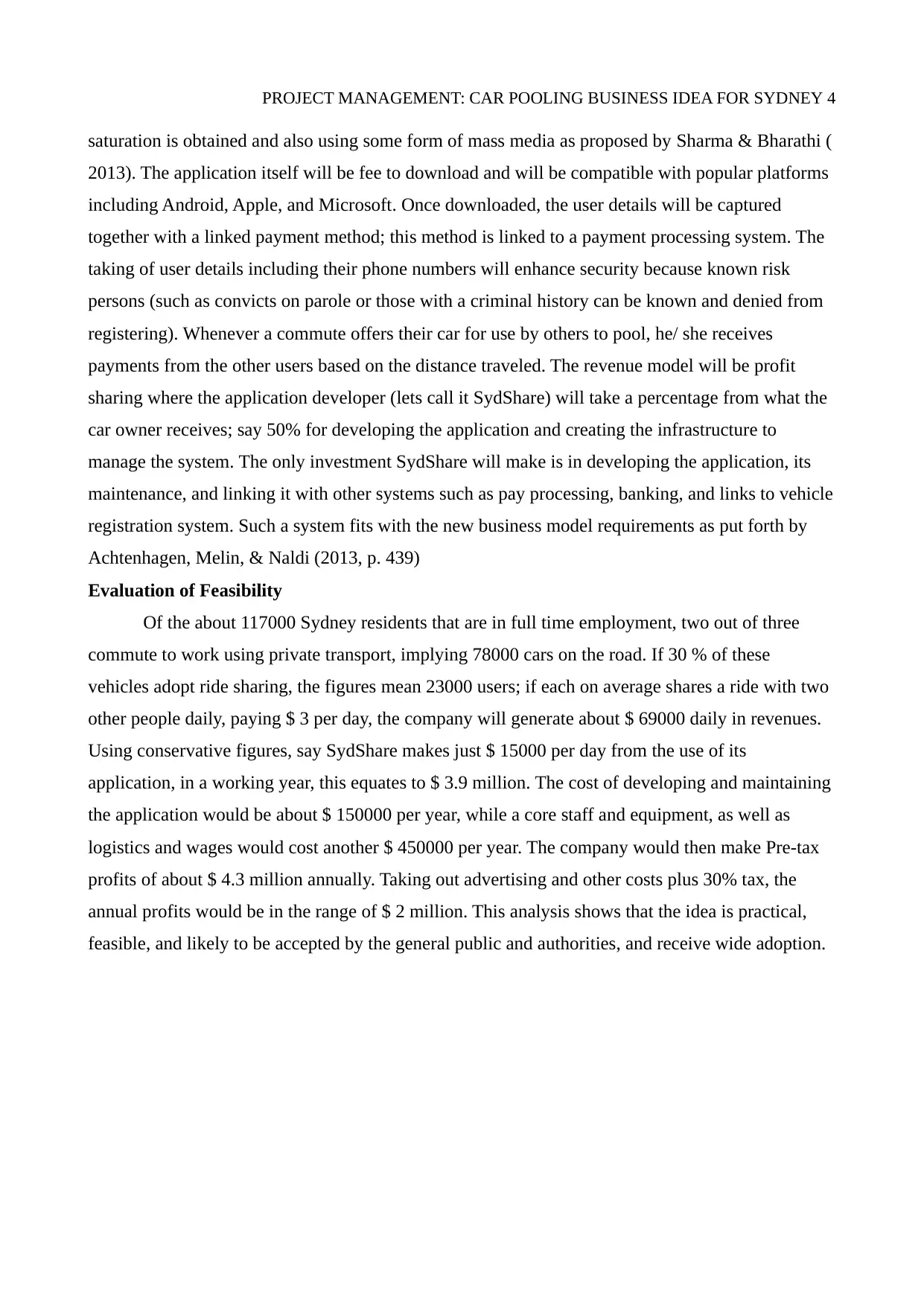
PROJECT MANAGEMENT: CAR POOLING BUSINESS IDEA FOR SYDNEY 4
saturation is obtained and also using some form of mass media as proposed by Sharma & Bharathi (
2013). The application itself will be fee to download and will be compatible with popular platforms
including Android, Apple, and Microsoft. Once downloaded, the user details will be captured
together with a linked payment method; this method is linked to a payment processing system. The
taking of user details including their phone numbers will enhance security because known risk
persons (such as convicts on parole or those with a criminal history can be known and denied from
registering). Whenever a commute offers their car for use by others to pool, he/ she receives
payments from the other users based on the distance traveled. The revenue model will be profit
sharing where the application developer (lets call it SydShare) will take a percentage from what the
car owner receives; say 50% for developing the application and creating the infrastructure to
manage the system. The only investment SydShare will make is in developing the application, its
maintenance, and linking it with other systems such as pay processing, banking, and links to vehicle
registration system. Such a system fits with the new business model requirements as put forth by
Achtenhagen, Melin, & Naldi (2013, p. 439)
Evaluation of Feasibility
Of the about 117000 Sydney residents that are in full time employment, two out of three
commute to work using private transport, implying 78000 cars on the road. If 30 % of these
vehicles adopt ride sharing, the figures mean 23000 users; if each on average shares a ride with two
other people daily, paying $ 3 per day, the company will generate about $ 69000 daily in revenues.
Using conservative figures, say SydShare makes just $ 15000 per day from the use of its
application, in a working year, this equates to $ 3.9 million. The cost of developing and maintaining
the application would be about $ 150000 per year, while a core staff and equipment, as well as
logistics and wages would cost another $ 450000 per year. The company would then make Pre-tax
profits of about $ 4.3 million annually. Taking out advertising and other costs plus 30% tax, the
annual profits would be in the range of $ 2 million. This analysis shows that the idea is practical,
feasible, and likely to be accepted by the general public and authorities, and receive wide adoption.
saturation is obtained and also using some form of mass media as proposed by Sharma & Bharathi (
2013). The application itself will be fee to download and will be compatible with popular platforms
including Android, Apple, and Microsoft. Once downloaded, the user details will be captured
together with a linked payment method; this method is linked to a payment processing system. The
taking of user details including their phone numbers will enhance security because known risk
persons (such as convicts on parole or those with a criminal history can be known and denied from
registering). Whenever a commute offers their car for use by others to pool, he/ she receives
payments from the other users based on the distance traveled. The revenue model will be profit
sharing where the application developer (lets call it SydShare) will take a percentage from what the
car owner receives; say 50% for developing the application and creating the infrastructure to
manage the system. The only investment SydShare will make is in developing the application, its
maintenance, and linking it with other systems such as pay processing, banking, and links to vehicle
registration system. Such a system fits with the new business model requirements as put forth by
Achtenhagen, Melin, & Naldi (2013, p. 439)
Evaluation of Feasibility
Of the about 117000 Sydney residents that are in full time employment, two out of three
commute to work using private transport, implying 78000 cars on the road. If 30 % of these
vehicles adopt ride sharing, the figures mean 23000 users; if each on average shares a ride with two
other people daily, paying $ 3 per day, the company will generate about $ 69000 daily in revenues.
Using conservative figures, say SydShare makes just $ 15000 per day from the use of its
application, in a working year, this equates to $ 3.9 million. The cost of developing and maintaining
the application would be about $ 150000 per year, while a core staff and equipment, as well as
logistics and wages would cost another $ 450000 per year. The company would then make Pre-tax
profits of about $ 4.3 million annually. Taking out advertising and other costs plus 30% tax, the
annual profits would be in the range of $ 2 million. This analysis shows that the idea is practical,
feasible, and likely to be accepted by the general public and authorities, and receive wide adoption.
Paraphrase This Document
Need a fresh take? Get an instant paraphrase of this document with our AI Paraphraser
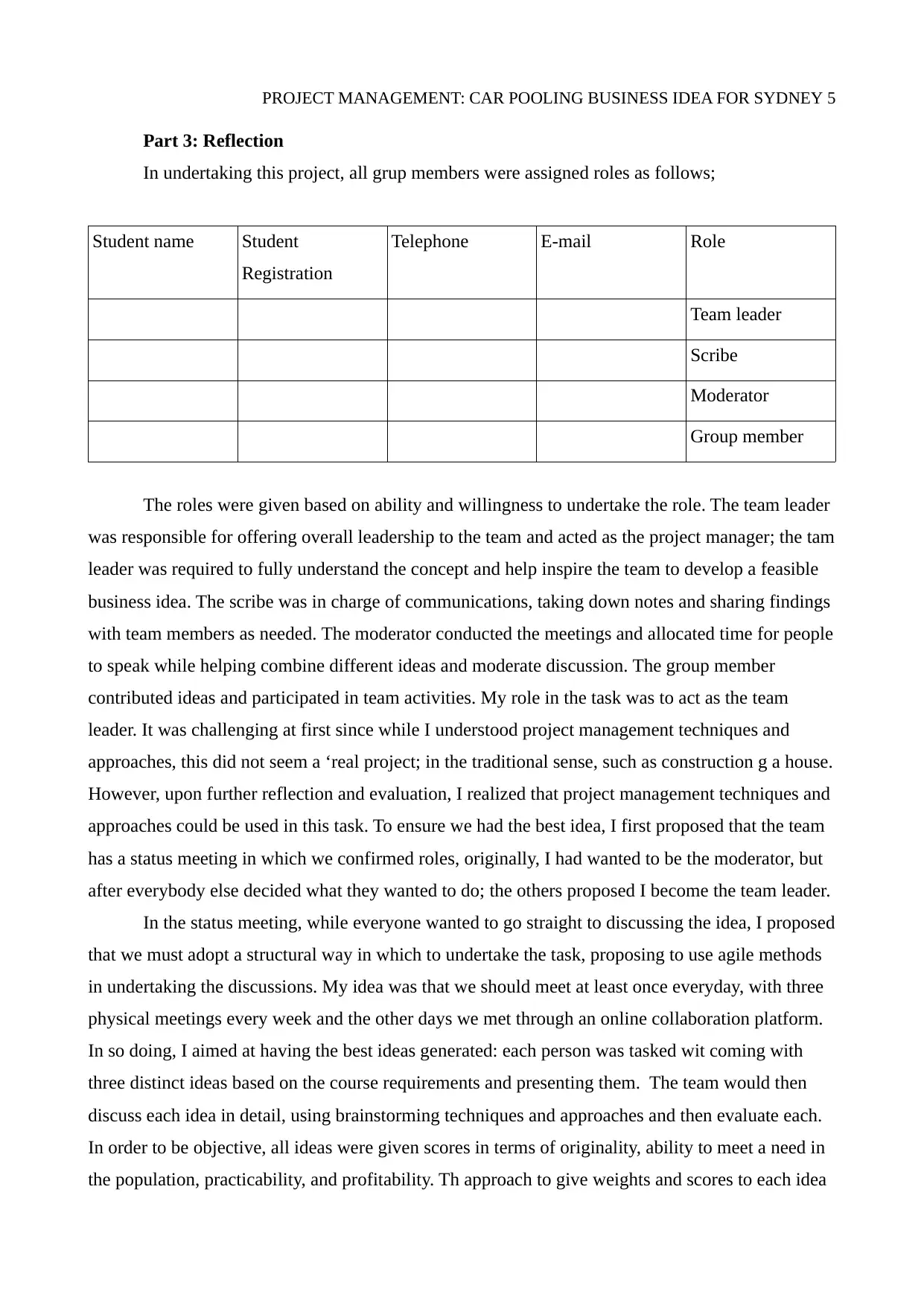
PROJECT MANAGEMENT: CAR POOLING BUSINESS IDEA FOR SYDNEY 5
Part 3: Reflection
In undertaking this project, all grup members were assigned roles as follows;
Student name Student
Registration
Telephone E-mail Role
Team leader
Scribe
Moderator
Group member
The roles were given based on ability and willingness to undertake the role. The team leader
was responsible for offering overall leadership to the team and acted as the project manager; the tam
leader was required to fully understand the concept and help inspire the team to develop a feasible
business idea. The scribe was in charge of communications, taking down notes and sharing findings
with team members as needed. The moderator conducted the meetings and allocated time for people
to speak while helping combine different ideas and moderate discussion. The group member
contributed ideas and participated in team activities. My role in the task was to act as the team
leader. It was challenging at first since while I understood project management techniques and
approaches, this did not seem a ‘real project; in the traditional sense, such as construction g a house.
However, upon further reflection and evaluation, I realized that project management techniques and
approaches could be used in this task. To ensure we had the best idea, I first proposed that the team
has a status meeting in which we confirmed roles, originally, I had wanted to be the moderator, but
after everybody else decided what they wanted to do; the others proposed I become the team leader.
In the status meeting, while everyone wanted to go straight to discussing the idea, I proposed
that we must adopt a structural way in which to undertake the task, proposing to use agile methods
in undertaking the discussions. My idea was that we should meet at least once everyday, with three
physical meetings every week and the other days we met through an online collaboration platform.
In so doing, I aimed at having the best ideas generated: each person was tasked wit coming with
three distinct ideas based on the course requirements and presenting them. The team would then
discuss each idea in detail, using brainstorming techniques and approaches and then evaluate each.
In order to be objective, all ideas were given scores in terms of originality, ability to meet a need in
the population, practicability, and profitability. Th approach to give weights and scores to each idea
Part 3: Reflection
In undertaking this project, all grup members were assigned roles as follows;
Student name Student
Registration
Telephone E-mail Role
Team leader
Scribe
Moderator
Group member
The roles were given based on ability and willingness to undertake the role. The team leader
was responsible for offering overall leadership to the team and acted as the project manager; the tam
leader was required to fully understand the concept and help inspire the team to develop a feasible
business idea. The scribe was in charge of communications, taking down notes and sharing findings
with team members as needed. The moderator conducted the meetings and allocated time for people
to speak while helping combine different ideas and moderate discussion. The group member
contributed ideas and participated in team activities. My role in the task was to act as the team
leader. It was challenging at first since while I understood project management techniques and
approaches, this did not seem a ‘real project; in the traditional sense, such as construction g a house.
However, upon further reflection and evaluation, I realized that project management techniques and
approaches could be used in this task. To ensure we had the best idea, I first proposed that the team
has a status meeting in which we confirmed roles, originally, I had wanted to be the moderator, but
after everybody else decided what they wanted to do; the others proposed I become the team leader.
In the status meeting, while everyone wanted to go straight to discussing the idea, I proposed
that we must adopt a structural way in which to undertake the task, proposing to use agile methods
in undertaking the discussions. My idea was that we should meet at least once everyday, with three
physical meetings every week and the other days we met through an online collaboration platform.
In so doing, I aimed at having the best ideas generated: each person was tasked wit coming with
three distinct ideas based on the course requirements and presenting them. The team would then
discuss each idea in detail, using brainstorming techniques and approaches and then evaluate each.
In order to be objective, all ideas were given scores in terms of originality, ability to meet a need in
the population, practicability, and profitability. Th approach to give weights and scores to each idea
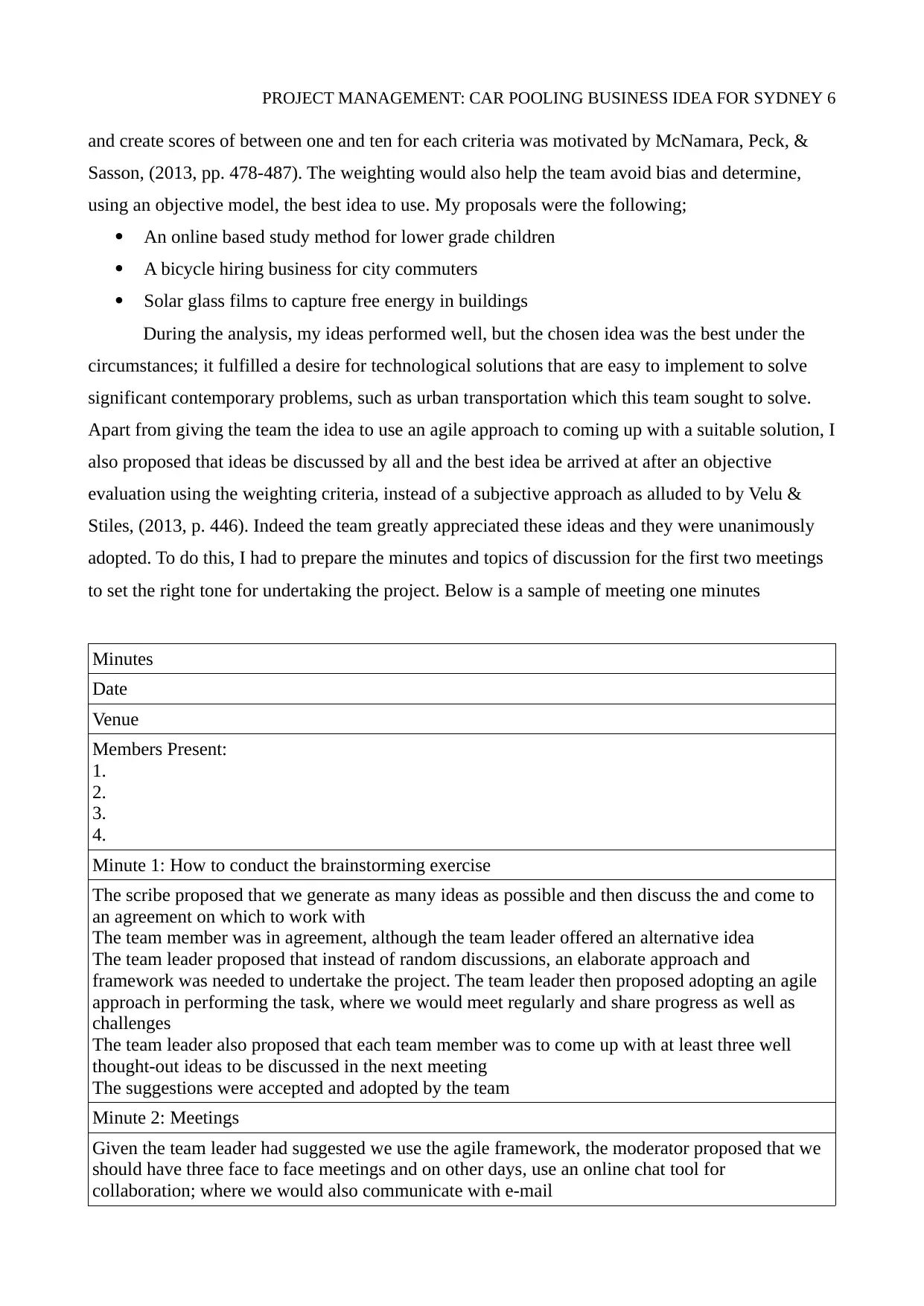
PROJECT MANAGEMENT: CAR POOLING BUSINESS IDEA FOR SYDNEY 6
and create scores of between one and ten for each criteria was motivated by McNamara, Peck, &
Sasson, (2013, pp. 478-487). The weighting would also help the team avoid bias and determine,
using an objective model, the best idea to use. My proposals were the following;
An online based study method for lower grade children
A bicycle hiring business for city commuters
Solar glass films to capture free energy in buildings
During the analysis, my ideas performed well, but the chosen idea was the best under the
circumstances; it fulfilled a desire for technological solutions that are easy to implement to solve
significant contemporary problems, such as urban transportation which this team sought to solve.
Apart from giving the team the idea to use an agile approach to coming up with a suitable solution, I
also proposed that ideas be discussed by all and the best idea be arrived at after an objective
evaluation using the weighting criteria, instead of a subjective approach as alluded to by Velu &
Stiles, (2013, p. 446). Indeed the team greatly appreciated these ideas and they were unanimously
adopted. To do this, I had to prepare the minutes and topics of discussion for the first two meetings
to set the right tone for undertaking the project. Below is a sample of meeting one minutes
Minutes
Date
Venue
Members Present:
1.
2.
3.
4.
Minute 1: How to conduct the brainstorming exercise
The scribe proposed that we generate as many ideas as possible and then discuss the and come to
an agreement on which to work with
The team member was in agreement, although the team leader offered an alternative idea
The team leader proposed that instead of random discussions, an elaborate approach and
framework was needed to undertake the project. The team leader then proposed adopting an agile
approach in performing the task, where we would meet regularly and share progress as well as
challenges
The team leader also proposed that each team member was to come up with at least three well
thought-out ideas to be discussed in the next meeting
The suggestions were accepted and adopted by the team
Minute 2: Meetings
Given the team leader had suggested we use the agile framework, the moderator proposed that we
should have three face to face meetings and on other days, use an online chat tool for
collaboration; where we would also communicate with e-mail
and create scores of between one and ten for each criteria was motivated by McNamara, Peck, &
Sasson, (2013, pp. 478-487). The weighting would also help the team avoid bias and determine,
using an objective model, the best idea to use. My proposals were the following;
An online based study method for lower grade children
A bicycle hiring business for city commuters
Solar glass films to capture free energy in buildings
During the analysis, my ideas performed well, but the chosen idea was the best under the
circumstances; it fulfilled a desire for technological solutions that are easy to implement to solve
significant contemporary problems, such as urban transportation which this team sought to solve.
Apart from giving the team the idea to use an agile approach to coming up with a suitable solution, I
also proposed that ideas be discussed by all and the best idea be arrived at after an objective
evaluation using the weighting criteria, instead of a subjective approach as alluded to by Velu &
Stiles, (2013, p. 446). Indeed the team greatly appreciated these ideas and they were unanimously
adopted. To do this, I had to prepare the minutes and topics of discussion for the first two meetings
to set the right tone for undertaking the project. Below is a sample of meeting one minutes
Minutes
Date
Venue
Members Present:
1.
2.
3.
4.
Minute 1: How to conduct the brainstorming exercise
The scribe proposed that we generate as many ideas as possible and then discuss the and come to
an agreement on which to work with
The team member was in agreement, although the team leader offered an alternative idea
The team leader proposed that instead of random discussions, an elaborate approach and
framework was needed to undertake the project. The team leader then proposed adopting an agile
approach in performing the task, where we would meet regularly and share progress as well as
challenges
The team leader also proposed that each team member was to come up with at least three well
thought-out ideas to be discussed in the next meeting
The suggestions were accepted and adopted by the team
Minute 2: Meetings
Given the team leader had suggested we use the agile framework, the moderator proposed that we
should have three face to face meetings and on other days, use an online chat tool for
collaboration; where we would also communicate with e-mail
⊘ This is a preview!⊘
Do you want full access?
Subscribe today to unlock all pages.

Trusted by 1+ million students worldwide
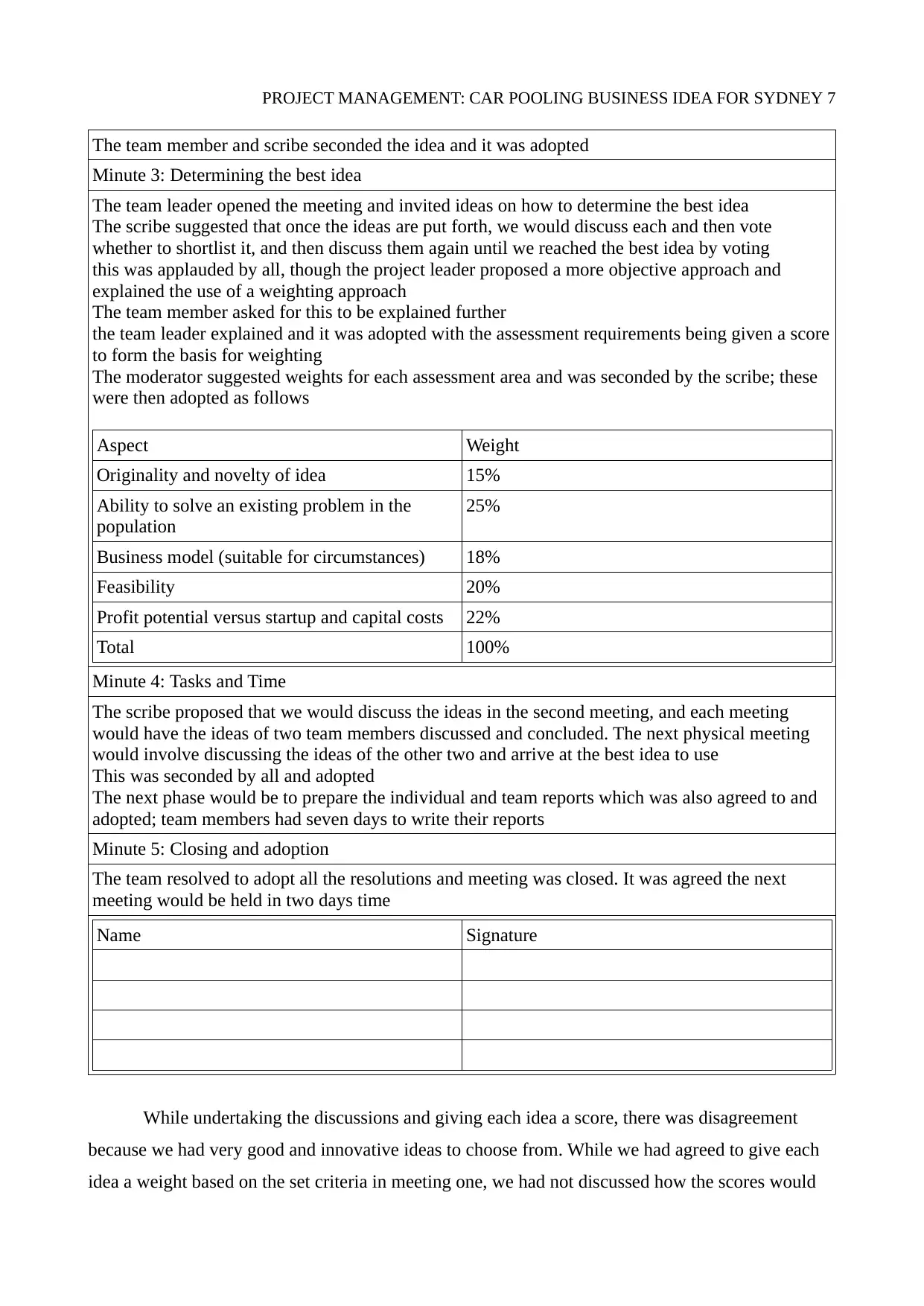
PROJECT MANAGEMENT: CAR POOLING BUSINESS IDEA FOR SYDNEY 7
The team member and scribe seconded the idea and it was adopted
Minute 3: Determining the best idea
The team leader opened the meeting and invited ideas on how to determine the best idea
The scribe suggested that once the ideas are put forth, we would discuss each and then vote
whether to shortlist it, and then discuss them again until we reached the best idea by voting
this was applauded by all, though the project leader proposed a more objective approach and
explained the use of a weighting approach
The team member asked for this to be explained further
the team leader explained and it was adopted with the assessment requirements being given a score
to form the basis for weighting
The moderator suggested weights for each assessment area and was seconded by the scribe; these
were then adopted as follows
Aspect Weight
Originality and novelty of idea 15%
Ability to solve an existing problem in the
population
25%
Business model (suitable for circumstances) 18%
Feasibility 20%
Profit potential versus startup and capital costs 22%
Total 100%
Minute 4: Tasks and Time
The scribe proposed that we would discuss the ideas in the second meeting, and each meeting
would have the ideas of two team members discussed and concluded. The next physical meeting
would involve discussing the ideas of the other two and arrive at the best idea to use
This was seconded by all and adopted
The next phase would be to prepare the individual and team reports which was also agreed to and
adopted; team members had seven days to write their reports
Minute 5: Closing and adoption
The team resolved to adopt all the resolutions and meeting was closed. It was agreed the next
meeting would be held in two days time
Name Signature
While undertaking the discussions and giving each idea a score, there was disagreement
because we had very good and innovative ideas to choose from. While we had agreed to give each
idea a weight based on the set criteria in meeting one, we had not discussed how the scores would
The team member and scribe seconded the idea and it was adopted
Minute 3: Determining the best idea
The team leader opened the meeting and invited ideas on how to determine the best idea
The scribe suggested that once the ideas are put forth, we would discuss each and then vote
whether to shortlist it, and then discuss them again until we reached the best idea by voting
this was applauded by all, though the project leader proposed a more objective approach and
explained the use of a weighting approach
The team member asked for this to be explained further
the team leader explained and it was adopted with the assessment requirements being given a score
to form the basis for weighting
The moderator suggested weights for each assessment area and was seconded by the scribe; these
were then adopted as follows
Aspect Weight
Originality and novelty of idea 15%
Ability to solve an existing problem in the
population
25%
Business model (suitable for circumstances) 18%
Feasibility 20%
Profit potential versus startup and capital costs 22%
Total 100%
Minute 4: Tasks and Time
The scribe proposed that we would discuss the ideas in the second meeting, and each meeting
would have the ideas of two team members discussed and concluded. The next physical meeting
would involve discussing the ideas of the other two and arrive at the best idea to use
This was seconded by all and adopted
The next phase would be to prepare the individual and team reports which was also agreed to and
adopted; team members had seven days to write their reports
Minute 5: Closing and adoption
The team resolved to adopt all the resolutions and meeting was closed. It was agreed the next
meeting would be held in two days time
Name Signature
While undertaking the discussions and giving each idea a score, there was disagreement
because we had very good and innovative ideas to choose from. While we had agreed to give each
idea a weight based on the set criteria in meeting one, we had not discussed how the scores would
Paraphrase This Document
Need a fresh take? Get an instant paraphrase of this document with our AI Paraphraser
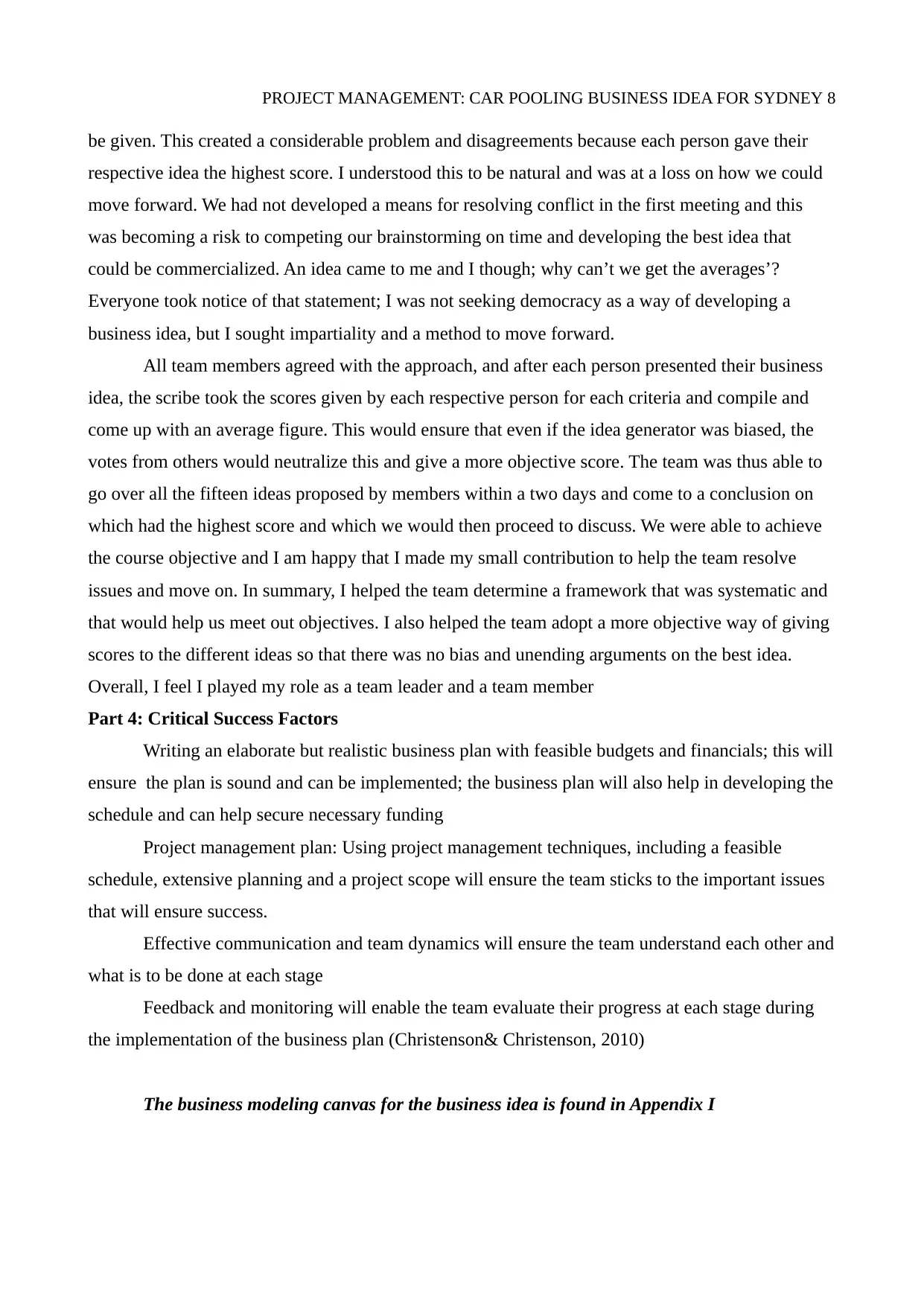
PROJECT MANAGEMENT: CAR POOLING BUSINESS IDEA FOR SYDNEY 8
be given. This created a considerable problem and disagreements because each person gave their
respective idea the highest score. I understood this to be natural and was at a loss on how we could
move forward. We had not developed a means for resolving conflict in the first meeting and this
was becoming a risk to competing our brainstorming on time and developing the best idea that
could be commercialized. An idea came to me and I though; why can’t we get the averages’?
Everyone took notice of that statement; I was not seeking democracy as a way of developing a
business idea, but I sought impartiality and a method to move forward.
All team members agreed with the approach, and after each person presented their business
idea, the scribe took the scores given by each respective person for each criteria and compile and
come up with an average figure. This would ensure that even if the idea generator was biased, the
votes from others would neutralize this and give a more objective score. The team was thus able to
go over all the fifteen ideas proposed by members within a two days and come to a conclusion on
which had the highest score and which we would then proceed to discuss. We were able to achieve
the course objective and I am happy that I made my small contribution to help the team resolve
issues and move on. In summary, I helped the team determine a framework that was systematic and
that would help us meet out objectives. I also helped the team adopt a more objective way of giving
scores to the different ideas so that there was no bias and unending arguments on the best idea.
Overall, I feel I played my role as a team leader and a team member
Part 4: Critical Success Factors
Writing an elaborate but realistic business plan with feasible budgets and financials; this will
ensure the plan is sound and can be implemented; the business plan will also help in developing the
schedule and can help secure necessary funding
Project management plan: Using project management techniques, including a feasible
schedule, extensive planning and a project scope will ensure the team sticks to the important issues
that will ensure success.
Effective communication and team dynamics will ensure the team understand each other and
what is to be done at each stage
Feedback and monitoring will enable the team evaluate their progress at each stage during
the implementation of the business plan (Christenson& Christenson, 2010)
The business modeling canvas for the business idea is found in Appendix I
be given. This created a considerable problem and disagreements because each person gave their
respective idea the highest score. I understood this to be natural and was at a loss on how we could
move forward. We had not developed a means for resolving conflict in the first meeting and this
was becoming a risk to competing our brainstorming on time and developing the best idea that
could be commercialized. An idea came to me and I though; why can’t we get the averages’?
Everyone took notice of that statement; I was not seeking democracy as a way of developing a
business idea, but I sought impartiality and a method to move forward.
All team members agreed with the approach, and after each person presented their business
idea, the scribe took the scores given by each respective person for each criteria and compile and
come up with an average figure. This would ensure that even if the idea generator was biased, the
votes from others would neutralize this and give a more objective score. The team was thus able to
go over all the fifteen ideas proposed by members within a two days and come to a conclusion on
which had the highest score and which we would then proceed to discuss. We were able to achieve
the course objective and I am happy that I made my small contribution to help the team resolve
issues and move on. In summary, I helped the team determine a framework that was systematic and
that would help us meet out objectives. I also helped the team adopt a more objective way of giving
scores to the different ideas so that there was no bias and unending arguments on the best idea.
Overall, I feel I played my role as a team leader and a team member
Part 4: Critical Success Factors
Writing an elaborate but realistic business plan with feasible budgets and financials; this will
ensure the plan is sound and can be implemented; the business plan will also help in developing the
schedule and can help secure necessary funding
Project management plan: Using project management techniques, including a feasible
schedule, extensive planning and a project scope will ensure the team sticks to the important issues
that will ensure success.
Effective communication and team dynamics will ensure the team understand each other and
what is to be done at each stage
Feedback and monitoring will enable the team evaluate their progress at each stage during
the implementation of the business plan (Christenson& Christenson, 2010)
The business modeling canvas for the business idea is found in Appendix I
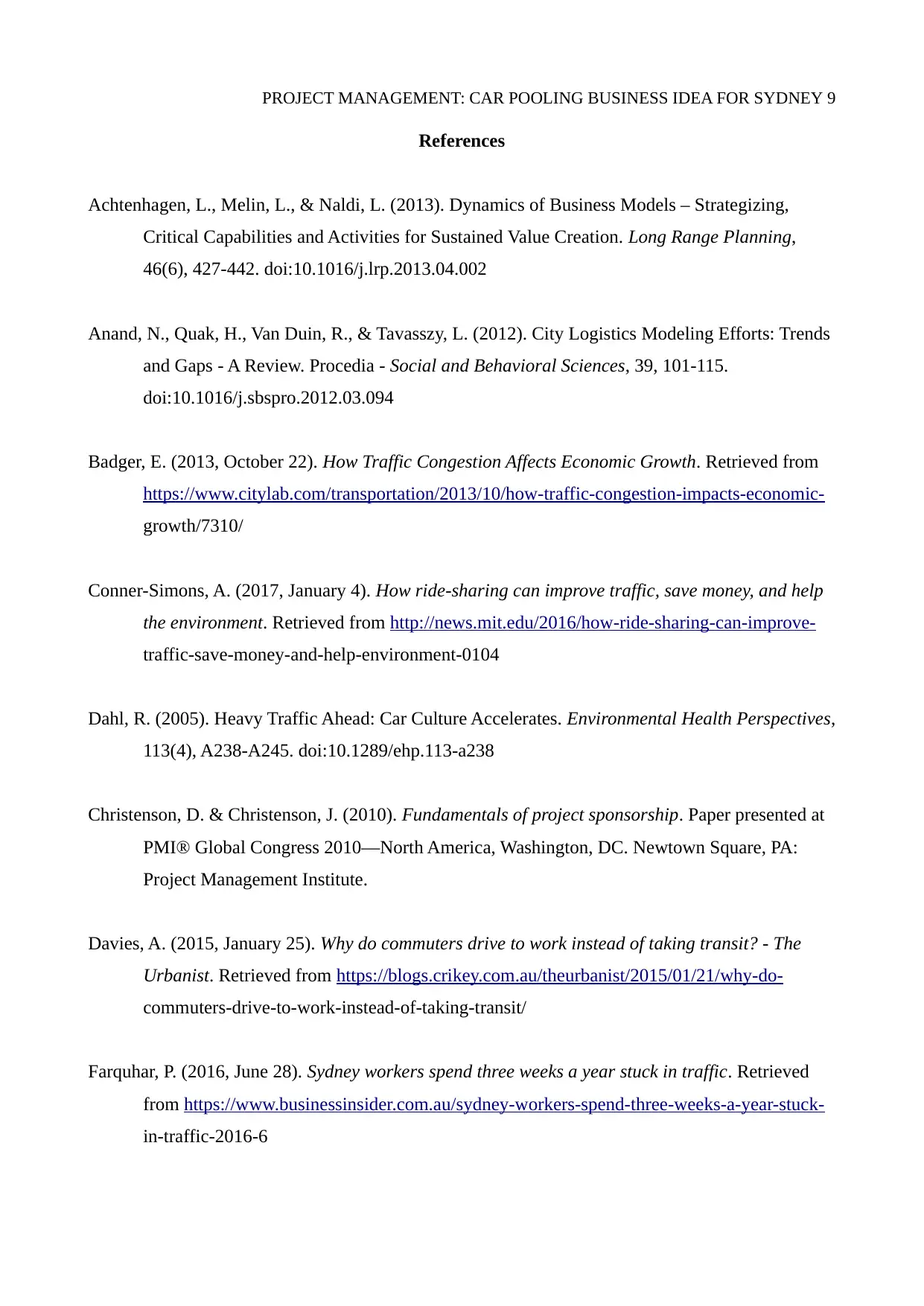
PROJECT MANAGEMENT: CAR POOLING BUSINESS IDEA FOR SYDNEY 9
References
Achtenhagen, L., Melin, L., & Naldi, L. (2013). Dynamics of Business Models – Strategizing,
Critical Capabilities and Activities for Sustained Value Creation. Long Range Planning,
46(6), 427-442. doi:10.1016/j.lrp.2013.04.002
Anand, N., Quak, H., Van Duin, R., & Tavasszy, L. (2012). City Logistics Modeling Efforts: Trends
and Gaps - A Review. Procedia - Social and Behavioral Sciences, 39, 101-115.
doi:10.1016/j.sbspro.2012.03.094
Badger, E. (2013, October 22). How Traffic Congestion Affects Economic Growth. Retrieved from
https://www.citylab.com/transportation/2013/10/how-traffic-congestion-impacts-economic-
growth/7310/
Conner-Simons, A. (2017, January 4). How ride-sharing can improve traffic, save money, and help
the environment. Retrieved from http://news.mit.edu/2016/how-ride-sharing-can-improve-
traffic-save-money-and-help-environment-0104
Dahl, R. (2005). Heavy Traffic Ahead: Car Culture Accelerates. Environmental Health Perspectives,
113(4), A238-A245. doi:10.1289/ehp.113-a238
Christenson, D. & Christenson, J. (2010). Fundamentals of project sponsorship. Paper presented at
PMI® Global Congress 2010—North America, Washington, DC. Newtown Square, PA:
Project Management Institute.
Davies, A. (2015, January 25). Why do commuters drive to work instead of taking transit? - The
Urbanist. Retrieved from https://blogs.crikey.com.au/theurbanist/2015/01/21/why-do-
commuters-drive-to-work-instead-of-taking-transit/
Farquhar, P. (2016, June 28). Sydney workers spend three weeks a year stuck in traffic. Retrieved
from https://www.businessinsider.com.au/sydney-workers-spend-three-weeks-a-year-stuck-
in-traffic-2016-6
References
Achtenhagen, L., Melin, L., & Naldi, L. (2013). Dynamics of Business Models – Strategizing,
Critical Capabilities and Activities for Sustained Value Creation. Long Range Planning,
46(6), 427-442. doi:10.1016/j.lrp.2013.04.002
Anand, N., Quak, H., Van Duin, R., & Tavasszy, L. (2012). City Logistics Modeling Efforts: Trends
and Gaps - A Review. Procedia - Social and Behavioral Sciences, 39, 101-115.
doi:10.1016/j.sbspro.2012.03.094
Badger, E. (2013, October 22). How Traffic Congestion Affects Economic Growth. Retrieved from
https://www.citylab.com/transportation/2013/10/how-traffic-congestion-impacts-economic-
growth/7310/
Conner-Simons, A. (2017, January 4). How ride-sharing can improve traffic, save money, and help
the environment. Retrieved from http://news.mit.edu/2016/how-ride-sharing-can-improve-
traffic-save-money-and-help-environment-0104
Dahl, R. (2005). Heavy Traffic Ahead: Car Culture Accelerates. Environmental Health Perspectives,
113(4), A238-A245. doi:10.1289/ehp.113-a238
Christenson, D. & Christenson, J. (2010). Fundamentals of project sponsorship. Paper presented at
PMI® Global Congress 2010—North America, Washington, DC. Newtown Square, PA:
Project Management Institute.
Davies, A. (2015, January 25). Why do commuters drive to work instead of taking transit? - The
Urbanist. Retrieved from https://blogs.crikey.com.au/theurbanist/2015/01/21/why-do-
commuters-drive-to-work-instead-of-taking-transit/
Farquhar, P. (2016, June 28). Sydney workers spend three weeks a year stuck in traffic. Retrieved
from https://www.businessinsider.com.au/sydney-workers-spend-three-weeks-a-year-stuck-
in-traffic-2016-6
⊘ This is a preview!⊘
Do you want full access?
Subscribe today to unlock all pages.

Trusted by 1+ million students worldwide
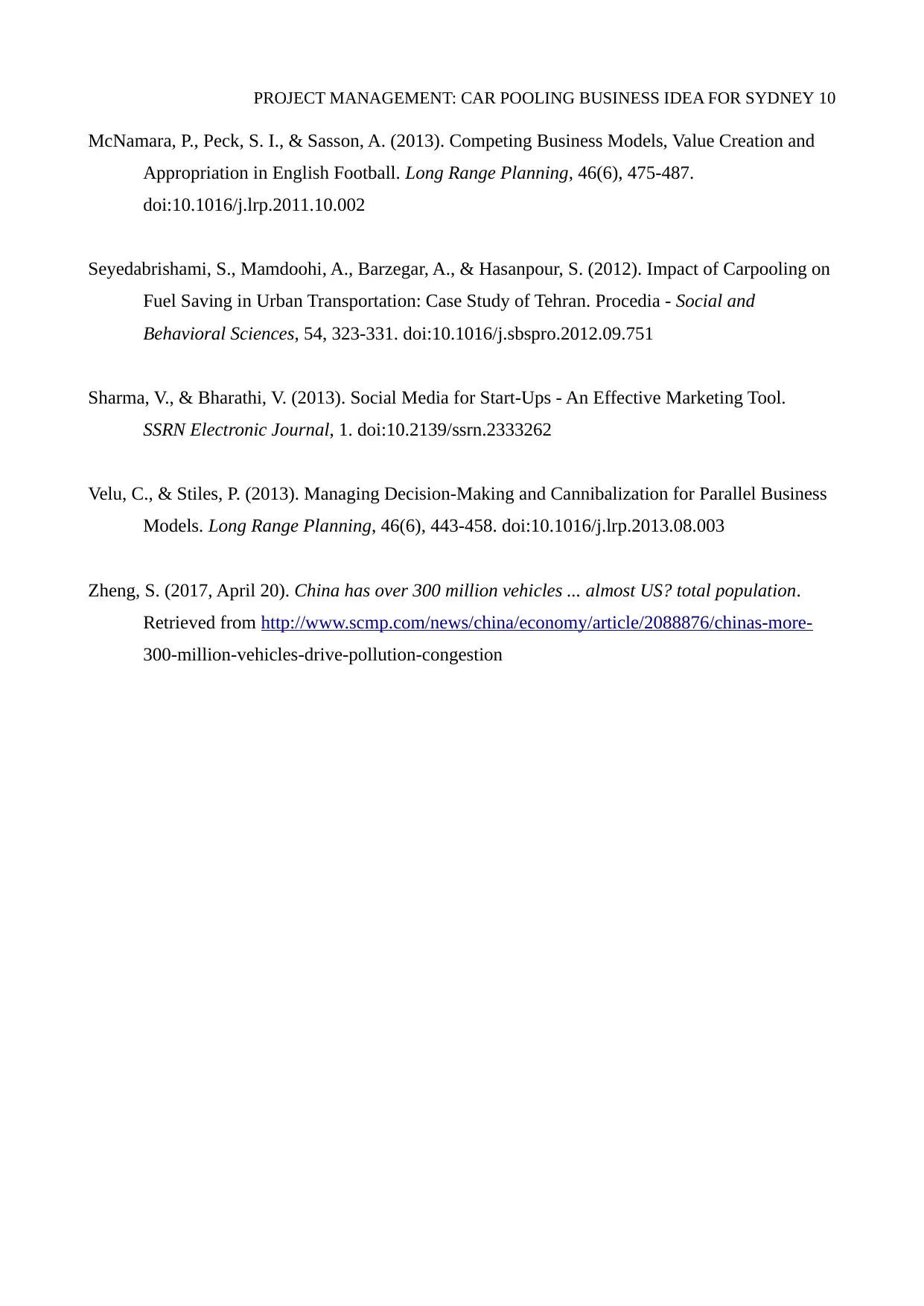
PROJECT MANAGEMENT: CAR POOLING BUSINESS IDEA FOR SYDNEY 10
McNamara, P., Peck, S. I., & Sasson, A. (2013). Competing Business Models, Value Creation and
Appropriation in English Football. Long Range Planning, 46(6), 475-487.
doi:10.1016/j.lrp.2011.10.002
Seyedabrishami, S., Mamdoohi, A., Barzegar, A., & Hasanpour, S. (2012). Impact of Carpooling on
Fuel Saving in Urban Transportation: Case Study of Tehran. Procedia - Social and
Behavioral Sciences, 54, 323-331. doi:10.1016/j.sbspro.2012.09.751
Sharma, V., & Bharathi, V. (2013). Social Media for Start-Ups - An Effective Marketing Tool.
SSRN Electronic Journal, 1. doi:10.2139/ssrn.2333262
Velu, C., & Stiles, P. (2013). Managing Decision-Making and Cannibalization for Parallel Business
Models. Long Range Planning, 46(6), 443-458. doi:10.1016/j.lrp.2013.08.003
Zheng, S. (2017, April 20). China has over 300 million vehicles ... almost US? total population.
Retrieved from http://www.scmp.com/news/china/economy/article/2088876/chinas-more-
300-million-vehicles-drive-pollution-congestion
McNamara, P., Peck, S. I., & Sasson, A. (2013). Competing Business Models, Value Creation and
Appropriation in English Football. Long Range Planning, 46(6), 475-487.
doi:10.1016/j.lrp.2011.10.002
Seyedabrishami, S., Mamdoohi, A., Barzegar, A., & Hasanpour, S. (2012). Impact of Carpooling on
Fuel Saving in Urban Transportation: Case Study of Tehran. Procedia - Social and
Behavioral Sciences, 54, 323-331. doi:10.1016/j.sbspro.2012.09.751
Sharma, V., & Bharathi, V. (2013). Social Media for Start-Ups - An Effective Marketing Tool.
SSRN Electronic Journal, 1. doi:10.2139/ssrn.2333262
Velu, C., & Stiles, P. (2013). Managing Decision-Making and Cannibalization for Parallel Business
Models. Long Range Planning, 46(6), 443-458. doi:10.1016/j.lrp.2013.08.003
Zheng, S. (2017, April 20). China has over 300 million vehicles ... almost US? total population.
Retrieved from http://www.scmp.com/news/china/economy/article/2088876/chinas-more-
300-million-vehicles-drive-pollution-congestion
Paraphrase This Document
Need a fresh take? Get an instant paraphrase of this document with our AI Paraphraser
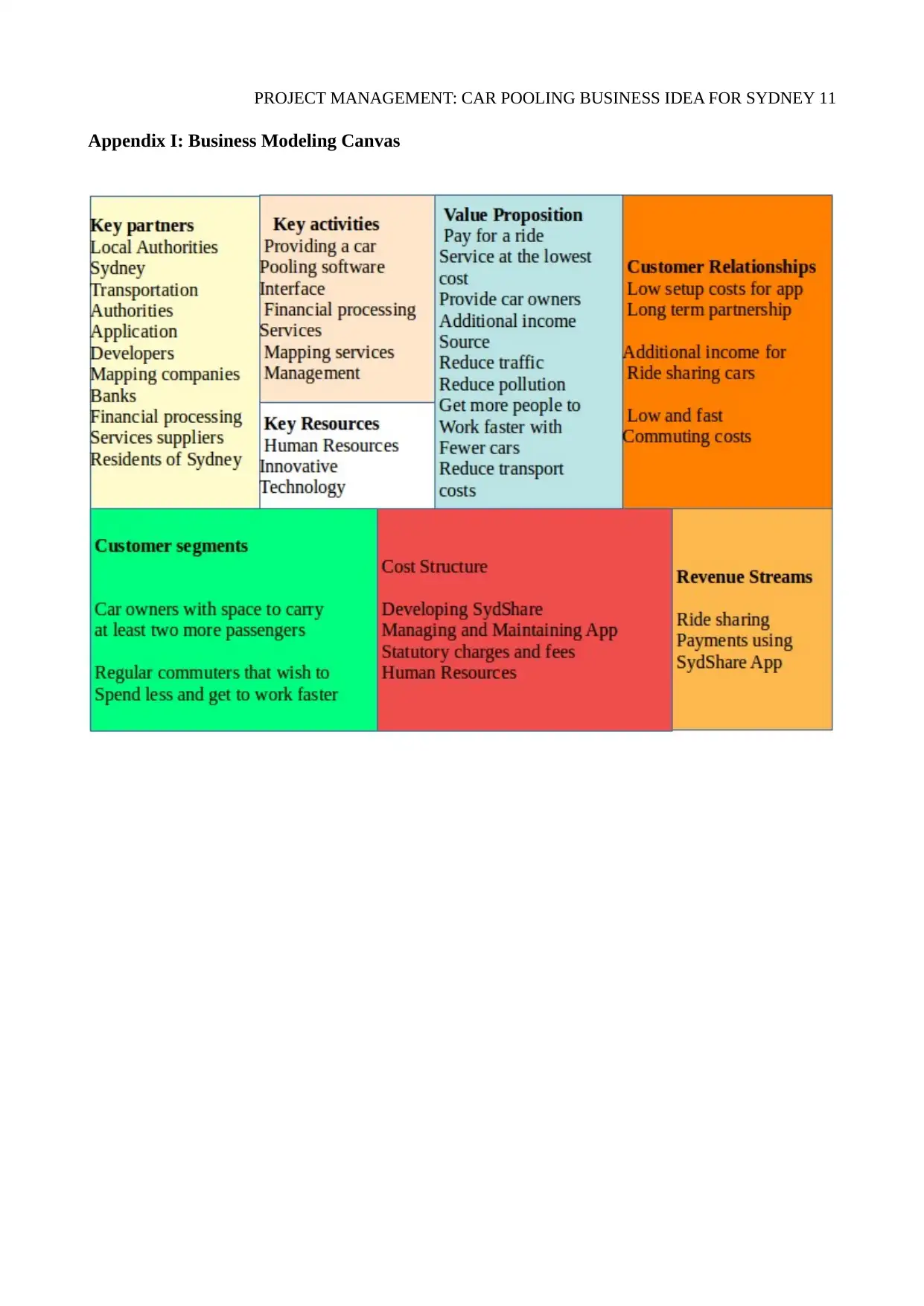
PROJECT MANAGEMENT: CAR POOLING BUSINESS IDEA FOR SYDNEY 11
Appendix I: Business Modeling Canvas
Appendix I: Business Modeling Canvas
1 out of 11
Your All-in-One AI-Powered Toolkit for Academic Success.
+13062052269
info@desklib.com
Available 24*7 on WhatsApp / Email
![[object Object]](/_next/static/media/star-bottom.7253800d.svg)
Unlock your academic potential
Copyright © 2020–2025 A2Z Services. All Rights Reserved. Developed and managed by ZUCOL.
